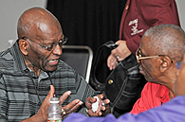December 15, 2025
Retirement Systems Modernization

(This article appeared in the November/December 2007 issue of The American Postal Worker magazine.)
Doug Holbrook, Director
Among the most difficult decisions that employees have to make are those regarding retirement. Many APWU members wait too long to gather and study the information needed to make good post-career choices.
The office of Personnel Management (OPM) currently houses more than 145,000 drawers of retirement files, and it is increasingly clear that the paper-based system no longer can adequately serve the federal process. During an average month, OPM will process more than 4,000 applications for retirement, with applications during peak months reaching 5,000.APWU members retire at an average rate of 350 per month; in some months the number reaches 500.
Over the past several years, the Postal Service has been moving toward a computer-based personnel system, but there is a ways to go before completion. The OPM, however, has mandated that all employers under the Civil Service Retirement System must provide computerized records for all of their employees. Beginning in February, the records of every active federal employee will be computerized. After discussion with the Postal Service, I have come to believe that this will be a positive change for future retirees.
The new system provides workers the ability to model their retirement and makes the benefits of a federal career more tangible.
Under this new system, the employee’s entire work record, including military time, will be immediately available online, with USPS Shared Services and OPM looking at the same work record. The computerized system should help enhance recruitment and employee retention by helping the government keep pace with retirement services that are already commonplace in the private sector.
Employees who go online will be able to immediately determine the value of their annuity. And OPM has said that within five days of receiving an employee’s retirement papers the final annuity determination will have been made. That means that employees’ first payment will reflect the full amount of their annuity instead of a partial payment.
A Fond Farewell
This is my last article for The American Postal Worker as I am retiring as director of the APWU Retirees Department. I sincerely thank President William Burrus and all the officers and staff for their support during the past 30 months.
When I leave this position (in mid-November), I will have spent almost 49 years with the union. I know the APWU will have continued success, and I look forward to hearing about the growth of both the union and the APWU Retirees Department.
The membership of the department is approximately 40,000. This is up from approximately 36,000 two-and-a-half years ago, but we have not begun to reach our potential. Every APWU local that has a sufficient number of retirees should have an active chapter. I would hope that all locals would make an effort — and soon — to establish a local chapter.
These chapters should not be established just for the national dues rebate, but to create an organization that would be involved with the local union and the community, and in state and national activities. We cannot afford to have our retirees be inactive, especially when so many who have made positive contributions to the labor movement can continue to do so.
Many retirees have spent a “career lifetime” with the union, and they have much to offer to the progressive growth of the American Postal Workers Union.
The choice is yours to make. I’m sure that my successor and the staff here will do everything possible to provide all information and assistance so that your local chapter will be successful.
There is no reason that anyone who retires should not continue their union membership by becoming an APWU Retiree.



